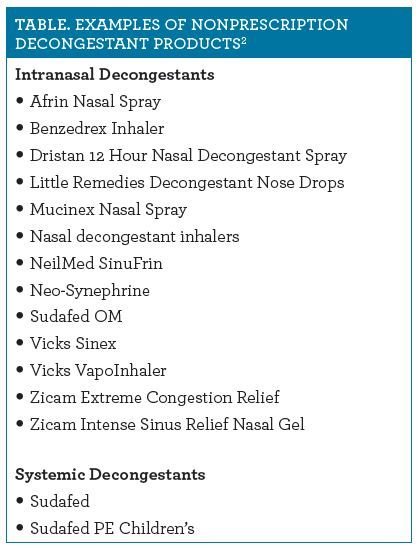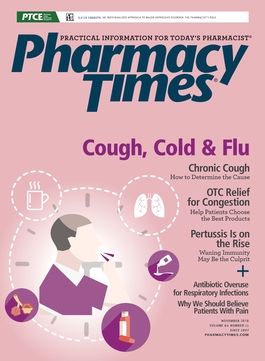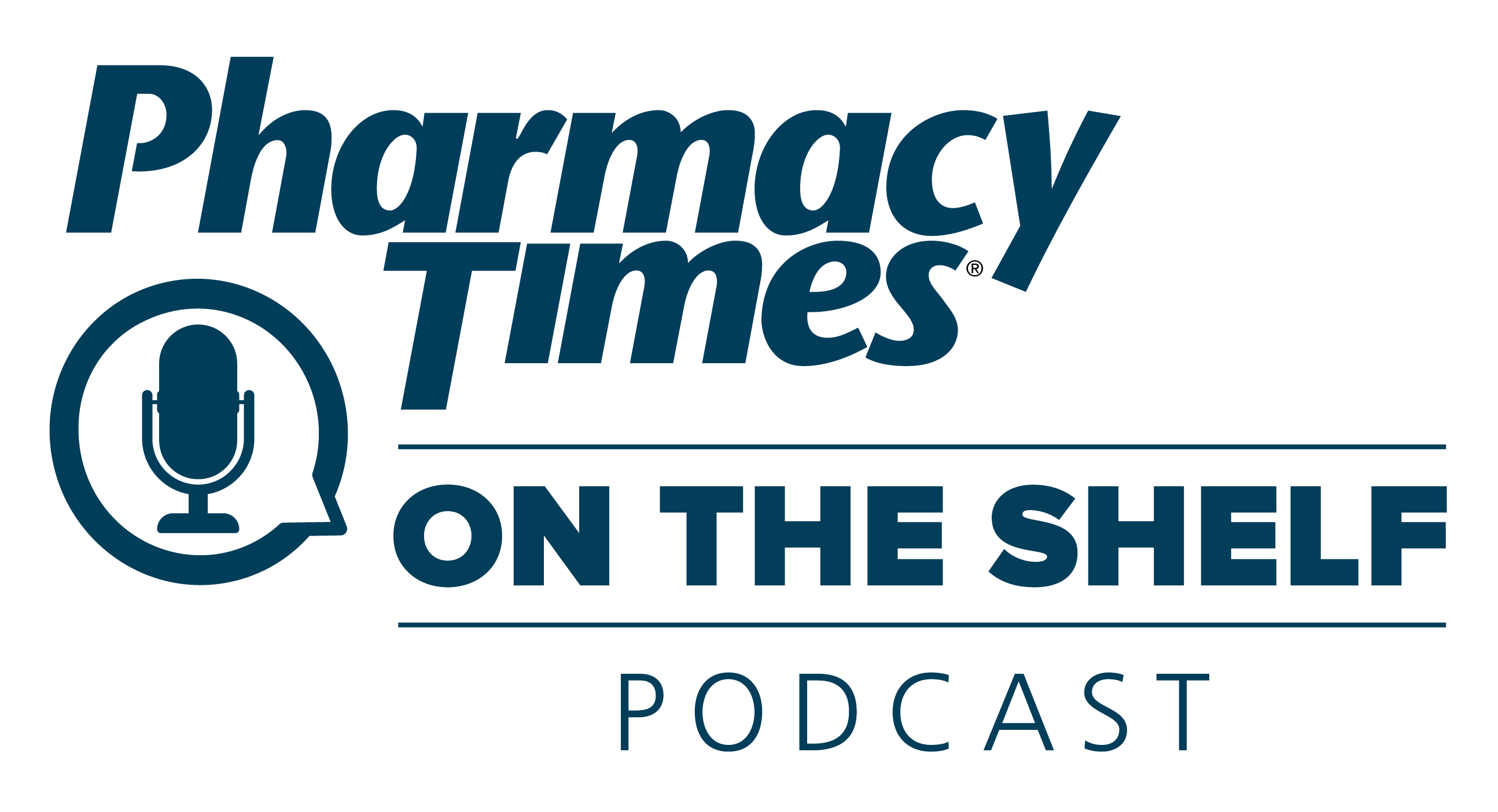Publication
Article
Pharmacy Times
A Guide to the Proper Use of Nonprescription Decongestant Products
Author(s):
Nasal congestion can negatively affect quality of life by interfering with day-to-day activities and disrupting sleep patterns.
Nasal congestion can negatively affect a person’s quality of life by interfering with day-to-day activities and disrupting the individual’s sleep pattern.
During this time of the year, as the peak cold and flu season starts, many patients are likely to seek counsel regarding the nonprescription cold, cough, and flu products on the market. Many of these cold and flu medications, as well as allergy products, contain decongestants. Pharmacists can be an indispensable resource when it comes to aiding patients in the proper use and selection of decongestant products, especially for those with preexisting medical conditions or who take other medications. Pharmacists can also be instrumental in identifying drugs, such as α-adrenergic receptor antagonists, angiotensin-converting-enzyme inhibitors, β-blockers, and oral contraceptives, that may cause nonallergic rhinitis in some patients.1 Aspirin and other nonsteroidal anti-inflammatory drugs may also produce nasal symptoms in sensitive individuals.1 Pharmacists can also refer patients to seek further medical care from their primary health care providers when warranted.
Decongestant Nonprescription Products
Decongestants are classified as adrenergic agonists (sympathomimetics) and exert their mechanism of action by stimulation of the α-adrenergic receptors, which constrict blood vessels, thereby decreasing sinusoid vessel enlargement and edema of the mucosal areas (Table).2 Nonprescription decongestants are not FDA approved to self-treat nasal congestion associated with sinusitis.2

Decongestants are indicated for the temporary relief of eustachian tube and nasal congestion and for cough associated with postnasal drip.2 Decongestant products are available in several dosage forms as combination and single-entity products, including pediatric formulations, to suit the needs of various patient populations. To avoid the unnecessary use of medications and therapeutic duplications, patients should be advised to use caution when using multi-ingredient products. If patients elect to use a combination product, they should be advised to use only those products that contain ingredients to treat their specific symptoms.
Available systemic nonprescription decongestants include phenylephrine and pseudoephedrine. Both have short half-lives and peak concentrations and occur at 0.5 to 2.0 hours after oral administration.2 Common adverse effects associated with oral decongestants include anxiety, insomnia, nervousness, palpitations, restlessness, and tachycardia.2
Available nonprescription intranasal decongestants include short-acting decongestants, such as ephedrine, levmetamfetamine, naphazoline, phenylephrine, and propylhexedrine, and long-acting decongestants, such as oxymetazoline and xylometazoline.2 Patients should be reminded that overuse of topical decongestants is associated with rhinitis medicamentosa (rebound congestion), and use of intranasal products should be limited to 3 to 5 days to avoid this condition.1,2
Because the use of decongestants is associated with cardiovascular stimulation, including arrhythmia, elevated blood pressure, palpitations, and tachycardia, they may exacerbate conditions that are sensitive to adrenergic stimulation, including coronary artery disease, hypertension, and ischemic heart disease, as well as interact with several other medications.
The use of decongestants may exacerbate other medical conditions, including diabetes, glaucoma, heart failure, prostatic hypertrophy, and thyroid disease.2,3 Patients on other medications or those with other medical conditions should be advised to consult their primary health care providers before using any of these products.2 Decongestants should be avoided in those taking certain antibiotics, such as linezolid, ergot derivatives, and monoamine oxidase inhibitors.2
Additionally, the FDA requires that the following warning be included on the label of all products that contain oral or topical decongestants: “Do not use this product if you have heart disease, high blood pressure, thyroid disease, diabetes, or difficulty in urination, due to enlargement of the prostate gland, unless directed by a doctor.”4
Conclusion
Prior to recommending any of these products, pharmacists should evaluate the patient’s allergy and medical histories and symptoms and screen for potential drug contraindications and interactions. During counseling, patients should be reminded to read labels prior to administration and to adhere to the recommended dosages, administration guidelines, and duration of use. It is especially critical for caregivers and patients to be reminded to always use calibrated measuring devices when administering liquids and to read all labels prior to administering medications to children to ensure proper accuracy and dosage. Caregivers and parents should give children only products manufactured specifically for the pediatric population and consult their pediatrician or pharmacist when in doubt regarding the appropriateness or dose of the medication. Lactating and pregnant women and patients with chronic medical conditions should always confer with their primary health care providers prior to using any nonprescription medication.
For patients with hypertension, when no other contraindications such as allergy to product ingredients are present, pharmacists may direct them to the nasal decongestant propylhexedrine marketed as Benzedrex (B.F. Ascher & Co, Inc), which is not required to carry the warning regarding against use in the patient population with hypertension.5 Additionally, inhalers that contain the decongestant levmetamfetamine also do not contain the FDA warning.6
Pharmacists can also recommend the nonmedicated inhalers such as Non-Medicated Vicks VapoInhalers (P&G Brands) that contain menthol and the nonmedicated nasal strips marketed as Breathe Right (GlaxoSmithKline) for relief from nasal congestion. Nonpharmacologic remedies include nasal steam inhalation, which can be very effective and provide temporary relief for nasal congestion. There is an assortment of personal steam inhalation machines as well as a host of diffusers that emit the aromas of essential oils, such as eucalyptus and peppermint, which may provide temporary relief from nasal congestion. Patients should be advised to discuss any concerns with their primary health care providers prior to using any of these therapies.
Yvette C. Terrie, BSPharm, RPh, is a consulting pharmacist and a medical writer in Haymarket, Virginia.
References
- Dykewicz MS. Rhinitis medicamentosa. Medscape website. emedicine.medscape.com/article/995056-overview#a5. Updated January 2, 2018. Accessed September 12, 2018.
- Scolaro KL. Disorders related to colds and allergy. In: Krinsky DL, Ferreri SP, Hemstreet B, et al, eds. Handbook of Nonprescription Drugs. 19th ed. Washington, DC: American Pharmacists Association; 2018=.
- Leelathanalerk A, Rollins CJ, Krinsky DL. Common OTC medications may worsen heart failure. Pharm Today. 2017;23(4):16.
- CFR - Code of Federal Regulations Title 21. Drugs for human use. FDA website. www.accessdata.fda.gov/scripts/cdrh/cfdocs/cfcfr/CFRSearch.cfm?fr=341.80. Updated April 21, 2018. Accessed September 11, 2018.
- Benzedrex. B.F. Ascher & Co, Inc, website. bfascher.com/category/benzedrex/. Accessed September 27, 2018.
- Label: vapor inhaler - levmetamfetamine nasal decongestant inhalant. US National Library of Medicine’s DailyMed website. dailymed.nlm.nih.gov/dailymed/drugInfo.cfm?setid=904b7e21-cce5-4b96-afc1-b36f532f98ac. Accessed September 27, 2018.

Newsletter
Stay informed on drug updates, treatment guidelines, and pharmacy practice trends—subscribe to Pharmacy Times for weekly clinical insights.






